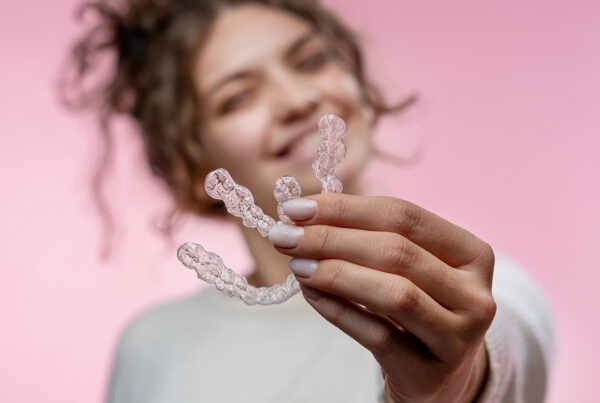If you just started your journey to a beautiful new smile and your orthodontist tells you that rubber bands will be a part of your treatment plan, you may have some questions!
Why are rubber bands used? How do they work? What happens if you don’t wear them? Here’s everything you need to know about braces rubber bands:
What are rubber bands?
Rubber bands are one of the most common types of orthodontic appliances used with braces.
They are tiny elastics that hook around a braces hook located on a top bracket of your braces as well as a bottom bracket.
These appliances are used during braces treatment (and sometimes Invisalign® treatment) to apply pressure to the top and bottom jaw bones, which helps guide them into proper alignment. Rubber bands are used to correct all types of misalignments, including overbites, underbites, midlines, crossbites and open bites.
Interarch rubber bands Vs. Colored elastics for braces
Interarch rubber bands are different from colored elastics for braces. These different braces’ elastics types serve different functions, and have different elasticity/resistance.
The interarch rubber bands are the ones that help align the jaw bones by applying pressure to the top and bottom teeth. (These are the ones you’re reading about in this guide!)
The colored elastics for braces are the tiny elastics that wrap around each bracket to hold the archwire to the bracket. This prevents the archwire from slipping out of place and essentially “tightens” your braces. At each check-in appointment, we’ll replace these rubber bands with new ones to maintain the pressure applied to your teeth.
Both types of rubber bands are designed to apply pressure to your smile, but interarch bands align your jaws, while colored elastics align your teeth. Together, they help us create your perfect smile!
How important are rubber bands?
If rubber bands are included in your treatment plan, they’re integral to your transformation. It’s essential that you wear your rubber bands as frequently as prescribed. Aligning your jaw bones is a critical part of straightening your smile, treating any present orthodontic problems, and ultimately, achieving the results you came to us for!
In the event that you don’t wear your rubber bands as instructed, this can significantly delay your treatment progress and therefore push back your treatment end date. If you want to see your new smile as quickly as possible, it’s important that you wear your rubber bands and follow your personalized treatment plan to a tee.
Braces rubber bands: how long do I wear them?
In most cases, patients are prescribed to wear rubber bands 24/7 for anywhere from one month to eight months, or more. You could also be instructed to wear rubber bands part-time, half of the day. It all depends on your personalized treatment plan.
What is the proper braces elastics position for me?
When your orthodontist hands you your first bag of elastics, we’ll explain how to position your rubber bands, where to place them, how to attach them, and how long to wear them. Our goal is to answer all of your questions so you don’t have any lingering questions when you leave our office.
Your braces’ elastic positions will be determined based on your orthodontic condition, but here’s an example of how they’ll work:
Rubber band positions for underbite
If you have an underbite where your lower jaw extends further out than your upper jaw, your rubber bands are aimed to guide your lower jaw backward and your upper jaw forward into alignment. In this case, your rubber bands will be attached to a braces hook toward the back of your upper teeth, and one on the canines of your lower teeth.
This position would effectively guide your lower jaw backward.
Rubber band positions for overbite
If you have an overbite where your upper jaw extends further over your lower jaw, your elastics aim to shift the upper jaw backward and the lower jaw forward to align your smile.
In this case, your rubber bands will attach to a braces hook on the bottom teeth, toward the back of your mouth, and a hook on the top teeth, toward your top canines. The rubber band tension will start to pull the upper jaw backward and the lower jaw forward, effectively treating an overbite.
Still have questions about rubber bands with braces?
When you visit us for your complimentary consultation, we’ll explain everything you need to know! After Dr. Saxe examines your condition, takes diagnostic photos and x-rays and discusses your smile goals with you, we’ll discuss your personalized treatment plan in full detail.
Educating our patients is extremely important to us! We want you to be informed throughout your entire treatment process, because that’s how the greatest results are created.
Please don’t hesitate to reach out to us with any questions! We love to hear from you. We’re here to guide you through your treatment process.
If you’re looking for a top orthodontist in Summerlin, Las Vegas, we’d love to meet you! Request a complimentary exam today.






